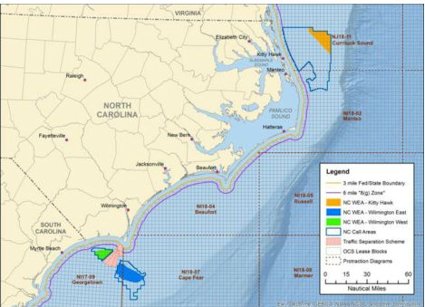The federal government yesterday took the next significant step toward developing commercial wind energy off the N.C. coast by releasing an environmental assessment that supports the potential lease sale for more than 300,000 acres in three areas, one off the northern Outer Banks and two near Wilmington.
“We are really pleased that the administration is continuing down the offshore wind path,” said Nancy Sopko, an ocean advocate with Oceana, a nonprofit group that advocates for world’s oceans and supports offshore wind development. “This is a big step forward, especially for North Carolina because of its abundant wind.”
Supporter Spotlight
The assessment, the first issued for a Southeast state, is another step in the long process of developing commercial wind farms off North Carolina, which studies have indicated has the best offshore wind resources on the East Coast.

The Bureau of Ocean Energy Management, or BOEM, prepared the 300-page assessment. The agency, part of the U.S. Department of Interior, regulates energy development in federal waters beyond the states’ three-mile territorial limits.
“No challenge poses a greater threat to future generations than climate change, and today’s announcement marks yet another milestone in the President’s strategy to develop renewable energy, create American jobs and strengthen the nation’s energy security future,” Sally Jewell, the Interior secretary, said yesterday in a press release accompanying the study. “In close coordination with our partners in North Carolina, we are moving forward to determine what places make sense to harness the enormous wind energy potential off the Atlantic seaboard.”
The study assesses the environmental effects of commercial wind farms in three areas off the coast:
- Wilmington West includes about 51,600 acres that begin about 10 nautical miles from shore and extend roughly 12.3 nautical miles in an east/west direction.
- Wilmington East includes about 133,600 acres that begin 15 nautical miles from shore and extend 18 nautical miles in a southeasterly direction.
- Kitty Hawk includes about 122,400 acres that begin 24 nautical miles from shore and extend seaward 13.5 nautical miles in a northeasterly direction.
The areas are all that’s left of the millions of offshore acres that BOEM and a task force of federal officials and state and local leaders began studying three years ago for wind development. Most areas were eliminated to protect important viewsheds, sensitive habitats and resources or to minimize conflicts with other activities such as military operations, shipping and fishing.
Supporter Spotlight
BOEM looked at the potential environmental effects associated only with issuing leases and approving site assessment activities in the three areas. Anyone leasing blocks for a commercial wind farm must then submit a construction and operations plan for BOEM’s review and approval. BOEM would then prepare a site-specific environmental analysis for the project proposed.
On the same day that that the agency released its environmental assessment of offshore wind leasing, North Carolina’s two Republican U.S. senators, Richard Burr and the newly elected Thom Tillis, introduced an amendment to a bill authorizing the controversial Keystone XL Pipeline that would force BOEM to include North Carolina in the next round of offshore leasing for oil and natural gas. The amendment would also allow East Coast states to share in royalties from any drilling in federal waters off their coasts. Current law doesn’t provide for that type of revenue sharing. The amendment is largely symbolic since President Obama has said he will veto the Keystone bill if it reaches his desk.
Tillis, in his first speech on the Senate floor, said the proposal is about creating opportunities for Americans. He said the proposal would support hundreds of thousands of jobs, reduce the cost of utilities for families and move the nation closer to energy independence.
Oceana, in a report released last week, noted that offshore wind would provide many more permanent jobs than oil and gas drilling and wouldn’t threaten North Carolina’s environment or coastal tourist-based economy.
“When it comes to the Atlantic, it’s really a no-brainer as to which path to go down, especially for North Carolina, which has the best wind resources on the East Coast,” Sopko noted. “We should not be doubling down on these polluting energies of the past.”
The public can read the assessment on offshore wind leasing and submit comments on BOEM’s website during the 30-day comment period that begins today. BOEM will also hold three public meetings next month to provide an overview of the findings and offer additional opportunities for public comments.
The meetings are scheduled for:
- Monday, Feb. 9, at a place to be determined along the northern Outer Banks
- Wednesday, Feb. 11, in Wilmington
- Thursday, Feb. 12 in Carolina Shores or Sunset Beach
After reviewing the public comments, BOEM will either move forward and begin leasing blocks in the area or revise the assessment. Based on the comments, the agency could determine that leasing poses severe environmental consequences. It would then do a more comprehensive Environmental Impact Statement.
More information about the assessment and BOEM’s wind energy leasing program for North Carolina can be found here.







